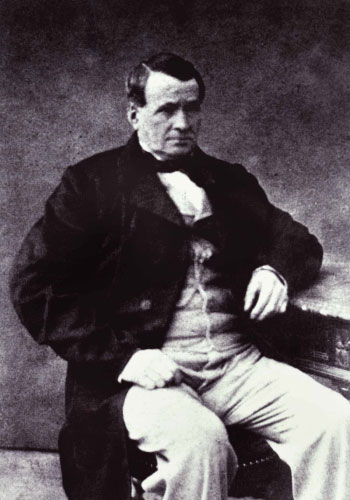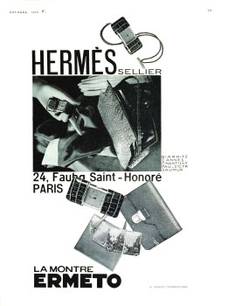Hermès, the root and the wings
At Hermès, five generations of enterprising artisans have opened up new domains and conquered new markets. Throughout, the House has grown in a spirit of inventive fidelity to the essential values handed down from its founders who guided its first steps into a century eager for change and progress. As respectful of the past as they were enthusiastic about the future, they passed on to their successors a fervent appreciation of fine materials and simple presentation, a love of superb craftsmanship made to last, and the energy to keep on innovating.

• In 1837 Thierry Hermès (1801-1878) opened a harness and saddle workshop in the Grands Boulevards quarter of Paris, then echoing with the clatter of horseshoes. At the 1867 Exposition Universelle, the jury awarded Hermès the First Class Medal.
• Charles-Émile Hermès (1831-1916) took over from his father and, in 1880, moved the family saddlery to 24, Faubourg Saint-Honoré, near the presidential Palais de l'Élysée. Soon assisted by his own sons, Adolphe and Émile-Maurice, he built up an elite cosmopolitan clientele in Europe, North Africa, Russia, the Americas and even Asia.
• Under the name of Hermès Frères (1902-1919), the company made a vigorous start to the 20th century, continuing to expand its work as a prestigious saddler. By 1900, the firm offered its customers a special haut à courroies bag ingeniously designed so that the riders could carry their saddles with them. By 1914, Adolphe and his younger brother Émile-Maurice were employing between 70 and 80 specialised saddlers. However, they also kept a close watch on developments in the nascent automotive industry. Sent to the United States during the First World War to supervise leather purchases for the French Cavalry, Émile-Maurice discovered a continent which had entered the era of mass production and whose great leaps in the technology of transport had stimulated a fast-growing luggage industry. Among the things that impressed him was the zip, or “American fastener.” He managed to obtain exclusive rights to use of the zipper for both leather goods and clothing and was thus the first to introduce the device in France.
• During the 1920s Émile-Maurice Hermès (1871-1951) remained alone at the head of the company. He now extended the Hermès name to “saddle-stitched” leather goods and, to its traditional products, added handbags and luggage, travel, sport and automotive accessories, silk scarves, belts, gloves, jewellery and wristwatches – demanding the same perfection throughout. The father of four daughters, Émile Hermès soon had three sons-in-law: Robert Dumas, Jean-René Guerrand and Francis Puech, whom he nurtured as highly effective partners with complementary talents. The House now opened branches in leading French resorts and established itself in the United States in 1924. Visitors to France from all around the world were sure to visit Hermès.
As if in response to the uncertainty born of the Great Depression, it was in the 1930s that the House launched some of its greatest classics. Since that time, the handbag later to be known as the Kelly bag, the Sac à dépêches (1935), the Chaîne d'ancre bracelet (1938) and the riding jacket and outfit have all joined the roll call of legendary Hermès classics. Silk, which had hitherto been confined to jockeys' tunics, now inspired the creation of scarves which Hermès first designed in 1937. That same year, the House celebrated its birthday as a very youthful centenarian. Its designers could now draw inspiration from the marvellous collection of paintings, books and objets d'art put together with such passion by Émile Hermès and regularly enriched by his successors.
• When Émile Hermès died in 1951, he was succeeded by his son-in-law Robert Dumas (1898-1978). The new chairman worked in close collaboration with his brother-in-law, Jean-René Guerrand. Equipped with its distinctive logo (the duc carriage with horse) and orange box, the brand continued its diversification; a range of ties was launched in 1949, soon followed by perfumes. In the spirit of Émile Hermès' fondness for creativity, Robert Dumas was intensely active, helping to inspire original new bags, jewellery and other accessories, many of which have since attained classic status. In particular, his special interest in the possibilities of silk scarves helped to make Hermès an incomparable master of illustration on silk. Brought to life by the magic wand of Annie Beaumel, the windows of the store on Faubourg Saint-Honoré became a theatre of enchantment and a Parisian meeting-place for international celebrities.
During these years, a photo of Grace Kelly showed the new Princess of Monaco carrying a Hermès handbag inspired by a model for riders. Immediately renamed Kelly (1956), the accessory became hugely popular. The Duke and Duchess of Windsor, Sammy Davis Junior, Ingrid Bergman, Lauren Bacall, Humphrey Bogart, John F. and Jackie Kennedy, and rising young stars such as Romy Schneider and Catherine Deneuve all appreciated and owned articles bearing the now mythical Hermès name. The 1970s saw new stores open all over Europe, Japan and the United States.
 |
 |
|---|
24, Faubourg Saint-Honoré
• With Jean-Louis Dumas, born in 1938, the fifth generation of the family took up the reins in 1978. Helped by his cousins, the new chairman breathed the excitement of youthful enthusiasm into the company, restructuring and stimulating its activities in silk, leather, and ready-to-wear, but also adding new product groups to those made with its traditional techniques. He set up a new watchmaking subsidiary, La Montre Hermès, at Biel, Switzerland, following up with enamel, china, silver and crystal. After the creation of a holding company in 1976, the Hermès Group extended and consolidated its presence around the world as Jean-Louis Dumas led the company in spectacular growth driven by his quest for perfection and coherence.
In 1987, Hermès celebrated its 150th birthday, affirming its unique identity as a company both industrial and traditional, multi-sited and Parisian, traditional and innovative, and founded on a constant striving for excellence. A dynamic communications policy proclaims these values around the world, emphasising their essential humanism and promoting Hermès' characteristic concern with creativity, its desire to foster dialogue between different cultures. In 1992 Hermès moved its production and workshops and design studios to a spacious new glass building in Pantin, on the outskirts of Paris.
• Today, the Hermès name is on 14 product families: Leather, Scarves, Ties, Menswear, Women' fashion, Perfume, Watches, Stationery, Footwear, Gloves, Enamel, Art of Living, Tableware, and Jewelry. Under the auspices of the Hermès International Company, some thirty companies responsible for production, wholesale distribution, retail sales are grouped in three distinct branches: Hermès Sellier, La Montre Hermès, and Hermès Parfums. It is distributed evenly among the three geographical areas: the Americas, the Pacific Ocean and Europe. A rigorous interior-architecture policy has conferred exceptional quality and cohesion on these stores, while integrating them with respect for the local culture of the countries where they are established.
The House subtly balances and blends the past, present and future tenses. Standing on the firm foundations built by the value of its materials and its original crafts, it is poised to rise even higher, ready to grow without losing its soul.




